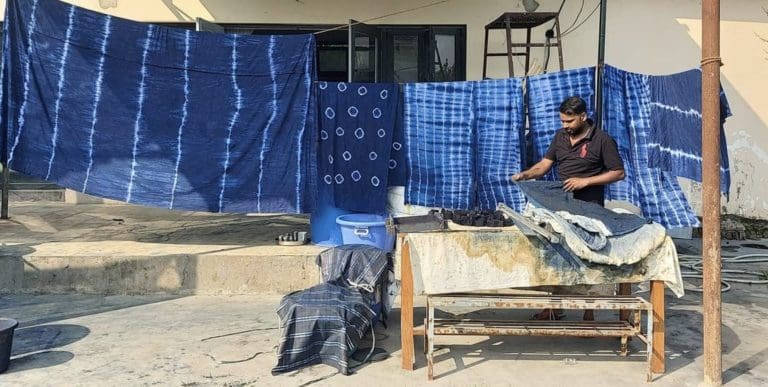At Indigowares, we believe that traceability is one of the key elements of the slow fashion movement. Since indigo and natural dyeing is the heart of our brand, I want to share the story of Kiran Sandhu, who supplies our indigo cakes.
Kiran— ‘Kinny’ for short— has such an incredible relationship with indigo growing, artistry, and her family’s geographical history. She is the perfect example of the amazing personal journeys that live within in each and every component of your garment.
Sandhu Farm sits in the foothills of the lower Himalayas. This is where Kinny grows her indigo. She calls her crop Tarai blue, a name that resonates both geographically and spiritually. Terai translates to ‘wetland’ and is used to refer to the region of marshy lowland between southern Nepal and northern India in which Kinny is located. Monsoons of the Terai region provide essential irrigation for farmers like Kinny, who calls them a ‘gift from God to India’. Sandhu farms thrives in these climate conditions, giving the soil the fertility to farm 4 crops a year.
Kinny and her husband have made a home here, immersed in the diversity of the Rudrapur, Uttarakhand. A large part of the regional culture has been formed from its refugee population. This was significantly established in 1947 by those displaced from Western Punjab after the Partition of India. This means that Kinny and her husband speak Punjabi in addition to Hindi. They also speak Bengali in light of the Bangladeshi population displaced in 1971 and use English frequently.
This diversity is reflected in the agricultural landscape of the Terai as well. Kinny is surrounded by farmers of wheat, rice, and sugar cane. And now, her own Indigofera Tinctoria.
Recently, Kinny shared this beautiful image of her indigo cakes on her Instagram to celebrate her indigotin’s testing result of 37%. This number represents the purity of the indigo. It is quantifiable evidence of the natural processes that are behind the indigo cakes that Kinny produces. This is quite an accomplishment in both the quality of Kinny’s crop and the transparency that she provides in her work.
In a world where synthetic materials are increasingly used, it is not always clear whether the indigo dye used in many retail garments has been organically created. Buyers of indigo cakes may make the assumption that the material is synonymous with a natural process— this is unfortunately not always the case. Cheap synthetic indigo can be created and extracted from petrochemicals, a manufacturing process that produces hazardous waste. Kinny has noticed that chemically produced are increasing in popularity and commonly mislabelled as organic.
This is what makes Kinny’s work all the more valuable. For one, her transparency in the process of indigo farming and testing sets the ultimate example of accountability. But Kinny brings the process of sharing these elements a step further— her social accounts are an amazing resource for anyone who wants to familiarise themselves with the origins of their dye. If you follow @kinnysandhu, you’ll find the photos we’ve featured here and many more, insights, paintings, and textiles.
All indigos are not made the same, and Kinny’s attention to tradition and purity of craft is one of the reasons we love using her indigo.

Even the quickest look through Kinny’s work reveals her as a passionate artist and creator. Kinny’s interest in indigo is clearly rooted in a great desire to learn the secrets of her trade. She began by studying textile design at the Women’s Polytechnic in Delhi. During her time there, she and her friends noticed that natural Indigo was difficult to find, and a passing suggestion was made that they should grow it organically. Kinny took this to heart and action— she ended up with 100 kilograms of organic indigo seeds and a new journey to begin.
Kinny then spent years learning the trade of farming and extracting indigo. She progressed from learning online, to uncovering secrets through workshops, and eventually hiring experts to show her how to begin her farm. Indigo now runs through every element of Kinny’s work, from growing to dyeing, and even to painting with indigo pigments. She is truly an indigo artist.
While Kinny initiated her own path into indigo farming, a connection to indigo reaches even further back through her family, to the land that she was raised on.
While she was growing up, Kinny’s family owned sugar factories and a distillery in Eastern Uttar Pradesh. This land was once indigo plantations, grounds that have a history of revolt. This began in 1859, when farmers refused to grow indigo for European planters during the Indigo Revolt in Bengal. This laid the foundation for India’s first civil disobedience movement in 1927— Champaran Satyagraha led by Gandhi to protest injustice and unfair payment for indigo farmers.
Kinny has always considered this connection, having grown up surrounded by old farms with forgotten indigo tanks.
The value or Kinny’s natural dye is unmistakable. As we use it in our indigo dyeing processes, we are always reminded that the beauty of these garments is created from an agricultural product that gives back to the environment.
